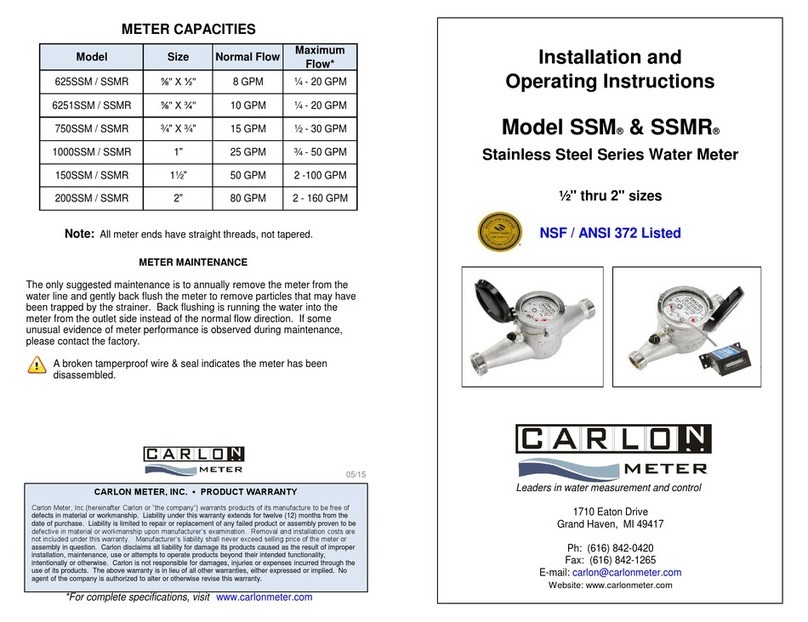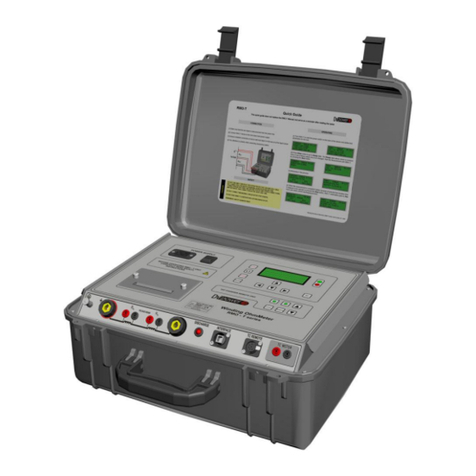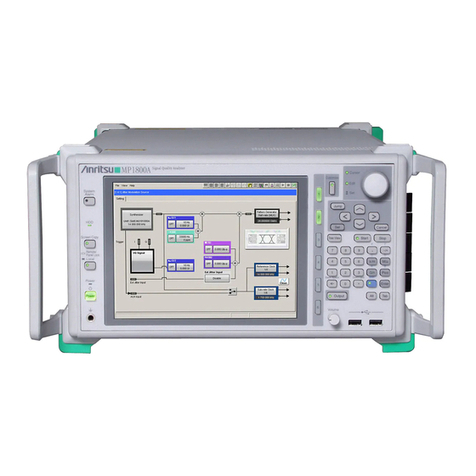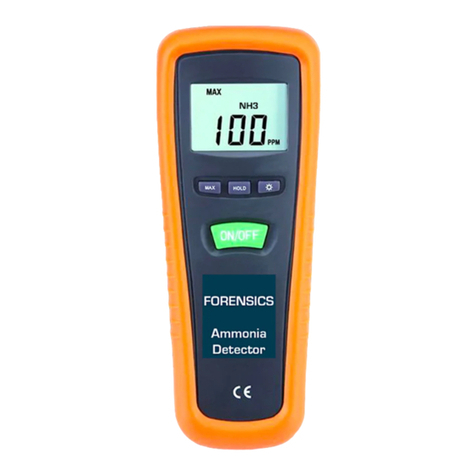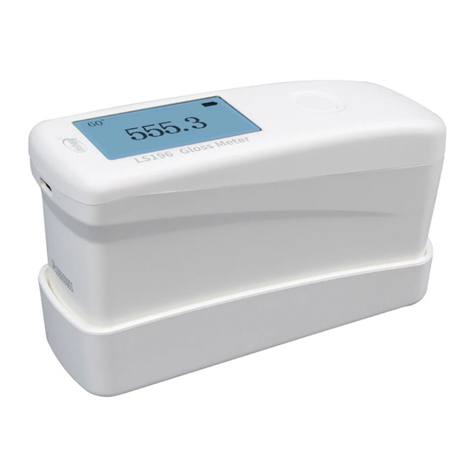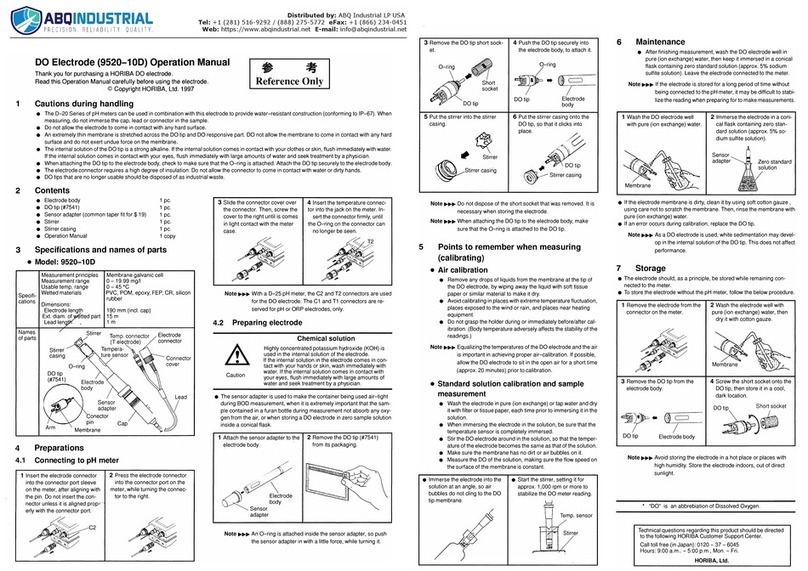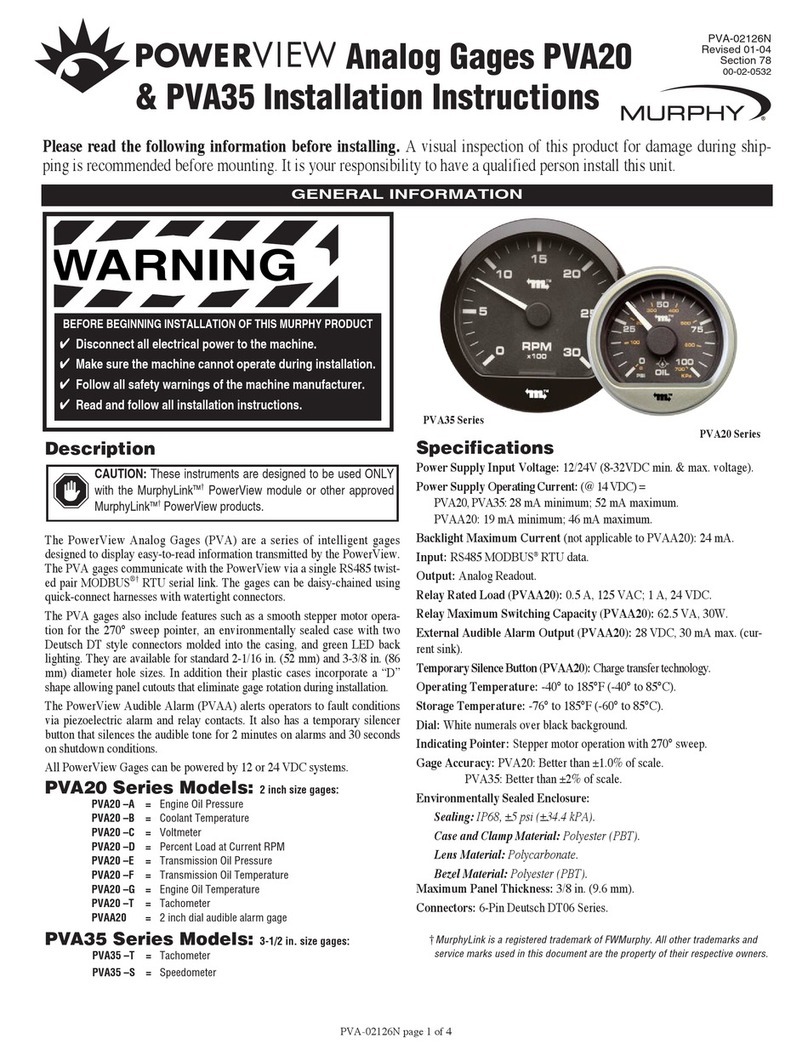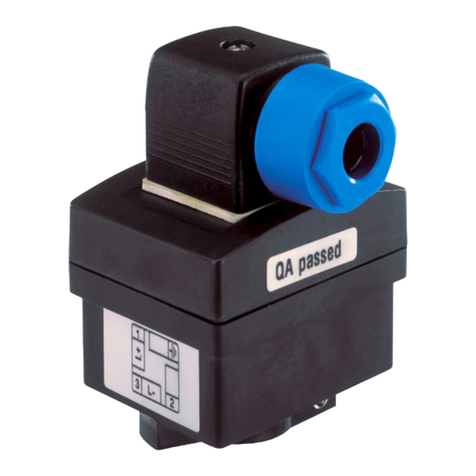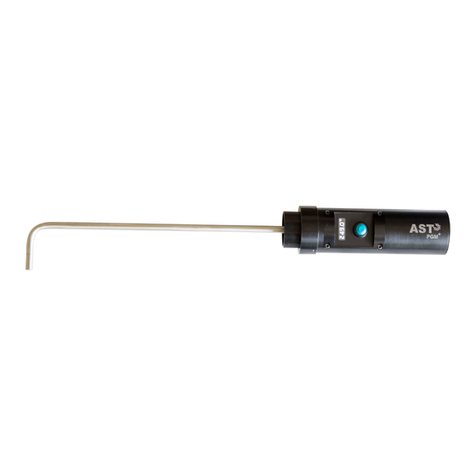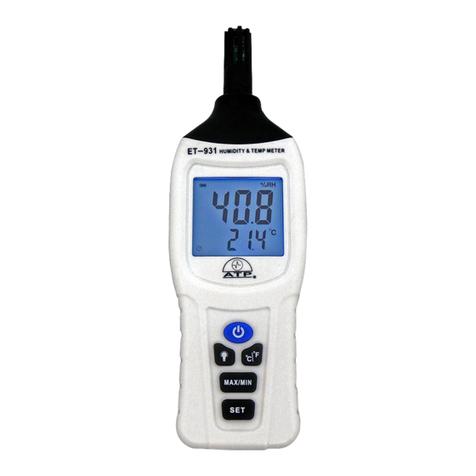CGEO INTERNATIONAL LIMITED CGEO-SG5 User manual

CGEO INTERNATIONAL LIMITED
Model CGEO-SG5
Rebar Vibrating Wire Strain Gauge
Installation Manual

CGEO-SG5 Rebar VW Strain Gauge 1
CGEO INTERNATIONAL LIMITED Installation Manual

CGEO-SG5 Rebar VW Strain Gauge 2
CGEO INTERNATIONAL LIMITED Installation Manual
TABLE of CONTENTS
Page
1. INTRODUCTION ..................................................................................................................3
2. INSTALLATION ...................................................................................................................4
2.1. Preliminary Tests .............................................................................................................................4
2.2. Rebar Strain Gauge Installation ....................................................................................................... 5
2.2.1. Model CGEO-SG5................................................................................................................ 5
2.2.2. Model CGEO-SG5-12 "Sister Bar"................................................................................. 6
2.3. Cable Installation .............................................................................................................................7
3. TAKING READINGS............................................................................................................8
3.1. Operation of the BSIL-RO-VW Readout Box................................................................................. 8
3.2. Measuring Temperatures..................................................................................................................8
4. DATA REDUCTION .............................................................................................................9
4.1. Strain Calculation.............................................................................................................................9
4.2. Temperature Correction...................................................................................................................9
4.3. Environmental Factors...................................................................................................................10
5. TROUBLESHOOTING........................................................................................................13
APPENDIX A - SPECIFICATIONS........................................................................................14
A.1. Rebar Strain Gauges
......................................................................................................................14
A.2 Thermistor (see Appendix B also)..................................................................................................14
APPENDIX B - THERMISTOR TEMPERATURE DERIVATION ......................................15

CGEO-SG5 Rebar VW Strain Gauge 3
CGEO INTERNATIONAL LIMITED Installation Manual
1. INTRODUCTION
CGEO-SG5 Vibrating Wire Rebar Strain Gauges are designed primarily for monitoring the
stresses in reinforcing steel in concrete structures, such as bridges, concrete piles and diaphragm
walls. The Strain Gauge is comprised of a length of high strength steel, bored along its central
axis to accommodate a miniature vibrating wire strain gage. Readout of load or stress is achieved
remotely using a portable readout or datalogging system available from Beijing Soil Instruments
Ltd.
The Model CGEO-SG5 Vibrating Wire Rebar Strain Gauge consists of a short length of high
strength steel welded between two long sections of reinforcing bar. It is designed to be welded
between sections of structural concrete reinforcing bar. The cable exits from the Strain Gauge
via a compression fitting. See Figure 1.
Rebar Strain Gauge Body Strain Gage Electromagnetic Coil Heat Shrink Weld Rebar
Weld
Thermistor
Compression Fitting Instrument Cable
900 mm
Figure 1 - Model CGEO-SG5 Rebar Strain Gauge
The Model CGEO-SG5-12 (diameter 12 ) Vibrating Wire Rebar Strain Gauge or "Sister Bar"
consists of a short length of high strength steel welded between two long sections of
reinforcing bar. It is designed to be wire tied in parallel with the structural rebar. The small
diameter of the bar minimizes its affect on the sectional modulus of the concrete. The cable
exits from the Strain Gauge through a small block of protective epoxy. See Figure 2.
Rebar Strain Gauge Body Strain Gage Electromagnetic Coil Heat Shrink Weld Rebar
Thermistor
(encapsulated)
Protective Epoxy Instrument Cable
900 mm
Figure 2 - Model CGEO-SG5 Sister Bar
Both models of Strain Gauges are robust, reliable and easy to install and read, and are
unaffected by moisture, cable length or contact resistance. The long term stability of these
instruments has proven to be excellent.

CGEO-SG5 Rebar VW Strain Gauge 4
CGEO INTERNATIONAL LIMITED Installation Manual
2. INSTALLATION
2.1. Preliminary Tests
It is always wise, before installation commences, to check the Strain Gauges for proper function.
Each Strain Gauge is supplied with a calibration sheet that shows the relationship between
readout digits and microstrain and also shows the initial no load zero reading. The Strain Gauge
electrical leads (usually the red and black leads) are connected to a readout box (see section 3)
and the zero reading given on the sheet is now compared to a current zero reading. Under normal
circumstances the two readings should not differ by more than about 25 digits (10 microstrain).
Shipping shocks may, however, cause larger shifts. If the reading is within 100 digits (40
microstrain) of the factory zero, and is stable, it is safe to proceed with the installation.
By pulling on the Strain Gauge it should be possible to change the readout digits, causing them
to rise as tension increases.
Checks of electrical continuity can also be made using an ohmmeter. For the CGEO-SG5,
resistance between the gage leads should be approximately 180 ±10 ohm. Remember to add
cable resistance when checking (stranded copper leads are approximately 50ohm /km,
multiply by 2 for both directions). Between the green and white should be approximately
3000 ohms at 25°(see Table B-1), and between any conductor and the shield should exceed
50 megohm.
Note: Do not lift the Strain Gauge by the cable.

CGEO-SG5 Rebar VW Strain Gauge 5
CGEO INTERNATIONAL LIMITED Installation Manual
2.2. Rebar Strain Gauge Installation
2.2.1. Model CGEO-SG5
The normal procedure is to weld the Strain Gauge in series with the reinforcing steel that is to
be instrumented on the site. For a typical installation see Figure 3. The Strain Gauge is long
enough so that it may be welded in place without damaging the internal strain gage element
(Figure 1).
However, care should still be taken to ensure that the central portion of the Strain Gauge does
not become too hot as the plucking coil and protective epoxy could melt. In order to prevent
this it may be necessary to place wet rags between the weld area and the coil housing. Also,
take care not to damage or burn the instrument cable when welding. After welding, route the
instrument cable along the rebar system and tie it off every 3-4 feet (1 meter) using nylon cable
ties. Avoid using iron tie wire to secure the cable as the cable could be cut.
Be sure when installing the Strain Gauges to note the location and serial numbers of all
instruments. This is necessary for applying the proper calibration factors and determining strain
characteristics when reducing data.
Guide Wall
Instrument Cables
Diaphragm Wall
Rebar Strain Gauges
(2 places, opposite)
Rebar Reinforcement
Concrete
Tieback (installed after excavation)
Material to be excavated
Rebar Strain Gauges
(2 places, opposite)
Tieback (installed after excavation)
Rebar Strain Gauges
(2 places, opposite)
Figure 3 - Model CGEO-SG5 Installation

CGEO-SG5 Rebar VW Strain Gauge 6
CGEO INTERNATIONAL LIMITED Installation Manual
2.2.2. Model CGEO-SG5-12 "Sister Bar"
The "Sister Bar" is usually installed using standard iron tie wire. Normally ties near the ends and
at the one third points are sufficient if the gage is being wired to a larger section of rebar or to
horizontal bars. Wiring at the one third points alone is sufficient if the gage is being wired in
parallel to the structural rebar. See Figures 4 and 5. Route the instrument cable along the rebar
system and tie it off every 3-4 feet (1 meter) using nylon cable ties. Avoid using the tie wire on
the instrument cable as it could cut the cable.
Be sure when installing the Strain Gauges to note the location and serial numbers of all
instruments. This is necessary for applying the proper calibration factors and determining load
characteristics when reducing data.
Instrument Cables Pile
Rebar Strain Gauges
(2 or 3 places)
Rebar Reinforcement or
Pre-Stressing Cables
Concrete
Rebar Strain Gauges
(2 or 3 places)
Rebar Strain Gauges
(2 or 3 places)
Figure 4 - Model CGEO-SG5 "Sister Bar" Installation

CGEO-SG5 Rebar VW Strain Gauge 7
CGEO INTERNATIONAL LIMITED Installation Manual
Instrument Cables
Instrument Cable
Reinforcing Rebar
or Strand
Reinforcing Rebar
or Strand
Wire Tie
(2 places)
Rebar Strain Gauge
Rebar Strain Gauge
(3 places, 120°apart)
Wire Tie
Tied to Reinforcing Rebar Tied to Reinforcing Rings
Figure 5 - Model CGEO-SG5 "Sister Bar" Installation Detail
2.3. Cable Installation
As noted in the installation sections, route the instrument cables along the structural rebar and
tie off using nylon cable ties every 2-3 feet (1 meter) to secure. Outside of the instrumented
structure, the cable should be protected from accidental damage caused by moving equipment or
other construction activity.
Cables may be spliced to lengthen them, without affecting gage readings. Always waterproof the
splice completely, especially when embedding within the concrete, preferably using an epoxy
based splice kit such the 3M Scotchcast , model 82-A1. These kits are available from the factory.

CGEO-SG5 Rebar VW Strain Gauge 8
CGEO INTERNATIONAL LIMITED Installation Manual
3. TAKING READINGS
3.1. Operation of the BSIL-RO-VW Readout Box
BSIL-RO-VW readout is suitable for all BSIL vibrating wire sensors.
Connect the Readout using the flying leads or in the case of a terminal station, with a connector.
The red and black clips are for the vibrating wire gage, the white and green clips are for the
thermistor and the blue for the shield drain wire.
1. Turn the display selector to position "B". Readout is frequency module and temperature
in ℃.
2. Turn the unit on and a reading will appear in the front display window. The last digit may
change one or two digits while reading. Press the "Store" button to record the value
displayed. If the no reading displays or the reading is unstable see section 5 for
troubleshooting suggestions. The thermistor will be read and output directly in degrees
centigrade.
3. Turn off the readout. Or the unit will automatically turn itself off after approximately 15
minutes to conserve power.
3.2. Measuring Temperatures
Each Vibrating Wire Rebar Strain Gauge is equipped with a thermistor for reading
temperature. The thermistor gives a varying resistance output as the temperature changes.
Usually the white and green leads are connected to the internal thermistor. BSIL-RO-VW
readout will read the thermistor and display temperature by connecting its white and green
leads to white and green leads of rebar strain gauge.
Following is instruction of using ohmmeter to read temperature:
1. Connect the ohmmeter to the two thermistor leads coming from the Strain Gauge. (Since
the resistance changes with temperature are so large, the effect of cable resistance is usually
insignificant.)
2. Look up the temperature for the measured resistance in Table B-1. Alternately the
temperature could be calculated using Equation B-1.

CGEO-SG5 Rebar VW Strain Gauge 9
CGEO INTERNATIONAL LIMITED Installation Manual
4. DATA REDUCTION
4.1. Strain Calculation
The basic units utilized by Soil for measurement and reduction of data from Vibrating Wire
Rebar Strain Gauges are "digits". Calculation of digits is based on the following equation;
Digits = Hz²/1000
Equation 1 - Digits Calculation
To convert digits to strain the following equation applies;
F= (R1 - R0) G
Equation 2 –Strain Caculation
Where: R0is the initial reading in digits, usually obtained at installation or at the
commencement of a test.
R1is the current reading in digits.
G is the calibration factor from the supplied calibration sheet (see Figure 6).
For example, assume an initial reading, R0, of 8000 digits, a current reading, R1, of 7700, and a
calibration factor, G, of 0.718439 microstrain per digit.
F= (7700 - 8000)* 0.718439 = - 215.5217 (compression)
Symbol rule:“-”:compression, “+”: tension
4.2. Temperature Correction
Rebar Strain Gauges are usually embedded in concrete and strained by the concrete, the
assumption being that the strain in the meter is equal to the strain in the concrete. When the
temperature changes, the concrete expands and contracts at a rate slightly less than the rate of the
steel of the vibrating wire. The coefficients of expansion are:
Steel (Ksteel):
12.2 ppm/°C
6.7 ppm/°F
Concrete (Kconcrete):
10 ppm/°C
5.5 ppm/°F
Difference (K):
2.2 ppm/°C
1.2 ppm/°F
Table 1 - Thermal Coefficients
Hence a correction is required to the apparent strains equal to the difference of these two
coefficients. See Equation 3.
F= G (R1- R0)+ K (T1- T0)
Equation 3 –Load Related Strain
Where: T0is the initial temperature recorded at the time of installation.
T1is the current temperature.

CGEO-SG5 Rebar VW Strain Gauge 10
CGEO INTERNATIONAL LIMITED Installation Manual
K is the thermal coefficient.
Normally the effect of temperature to VW strain gauge is little, it needn’t to be corrected. Detail
calculation method see calculation equation and related factor in calibration certificate.
4.3. Environmental Factors
Since the purpose of the Strain Gauge installation is to monitor site conditions, factors which
may affect these conditions should be observed and recorded. Seemingly minor effects may
have a real influence on the behavior of the structure being monitored and may give an early
indication of potential problems. Some of these factors include, but are not limited to: blasting,
rainfall, tidal or reservoir levels, excavation and fill levels and sequences, traffic, temperature
and barometric changes, changes in personnel, nearby construction activities, seasonal changes,
etc.

CGEO-SG5 Rebar VW Strain Gauge 11
CGEO INTERNATIONAL LIMITED Installation Manual
Model: CGEO-SG5-12-300 CGEO-PR-VW
Temperature:
24℃
S/N
Standard
pressure
Caculated
Pressure
Accuracy
Caculated
Pressure
Accuracy
(kN) 1st Cycle 2nd Cycle 3rd Cycle Linear (%FS) Polynomial (%FS)
0.0 4434.8 4434.6 4434.5 4434.6 -0.0481 -0.14 -0.0276 -0.08
7.0 4799.2 4796.8 4797.6 4797.8 7.067 0.19 7.063 0.18
14.0 5150.9 5152.2 5151.1 5151.4 13.993 -0.02 13.976 -0.07
21.0 5508.0 5509.4 5508.3 5508.6 20.99 -0.03 20.97 -0.08
28.0 5866.8 5867.8 5867.3 5867.3 28.02 0.05 28.01 0.03
35.0 6223.5 6222.5 6222.7 6222.9 34.98 -0.05 35.00 0.01
Linear F=
G ( R1 -R0 ) + K ( T1-T0 )
Polynomial F=
AR12 + BR1 + C + K ( T1-T0 )
(kN) Linear Gage Factor: G = 0.019589kN/Digit
(kN)Polynomial Gage Factor: A =
B =
C =
Thermal Factor: K =
0.01517kN/℃
R0 ....Original reading
T0 ....Original temperature
CGEO INTERNATIONAL LIMITED
Room 06, 13A/F., South Tower,
World Finance Centre, HarbourCity,
17 Canton Road, Tsim Sha Tsui, Kowloon,Hong Kong.
Tel: +852 2206 0092
Fax: +852 3003 0133
VIBRATING WIRE SISTER BAR STRAIN GAUGE CALIBRATION CERTIFICATE
Readout:
Humidity:
40%RH
-85.57492341994710
Average
Gage
123119567450
0.0000000479302936
0.0190782328003104
Gage Reading
Formula
Checked by: Zhaosong
Collator: WangYong
Certified by: Qinjuan
Calibration Date:
13/Mar/19

CGEO-SG5 Rebar VW Strain Gauge 12
CGEO INTERNATIONAL LIMITED Installation Manual
Figure 6 - Sample Model CGEO-SG5 Calibration Sheet

CGEO-SG5 Rebar VW Strain Gauge 13
CGEO INTERNATIONAL LIMITED Installation Manual
5. TROUBLESHOOTING
Maintenance and trouble shooting of Vibrating Wire Rebar Strain Gauges are confined to
periodic checks of cable connections. Once installed, the meters are usually inaccessible and
remedial action is limited.
Consult the following list of problems and possible solutions should difficulties arise. Consult
the factory for additional troubleshooting help.
Symptom: Strain Gauge Readings are Unstable
Is the readout box position set correctly? If using a datalogger to record readings
automatically are the swept frequency excitation settings correct? Channel B of the
BSIL-RO-VW readout can be used to read the Strain Gauge.
Is there a source of electrical noise nearby? Most probable sources of electrical noise are
motors, generators and antennas. Make sure the shield drain wire is connected to ground
whether using a portable readout or datalogger.
Check whether the connection of readout and strain gauge’s leads is well. Does the readout
work with another Strain Gauge? If not, the readout may have a low battery or be
malfunctioning.
Symptom: Strain Gauge Fails to Read
Is the cable cut or crushed? This can be checked with an ohmmeter. For the CGEO-SG5,
nominal resistance between the two gage leads (usually red and black leads) is 180ohm+/-10,
Remember to add cable resistance when checking (22 AWG stranded copper leads are
approximately 50ohm /km, multiply by 2 for both directions). If the resistance reads infinite,
or very high (megohms), a cut wire must be suspected. If the resistance reads very low ( <20
ohm ) a short in the cable is likely.
Does the readout or datalogger work with another Strain Gauge? If not, the readout or
datalogger may be malfunctioning.

CGEO-SG5 Rebar VW Strain Gauge 14
CGEO INTERNATIONAL LIMITED Installation Manual
APPENDIX A - SPECIFICATIONS
A.1. Rebar Strain Gauges
Model
CGEO-SG5 “sister
bar”
CGEO-SG5
Standard Ranges
210MPa(1000με)
300MPa(1500με)
400MPa(2000με)
Diameter
12mm
14, 16, 18, 20, 22,
25, 28, 32, 36, 40mm
25, 28, 32, 36, 40mm
Accuracy
0.25%F.S.
Resolution
0.016%F.S.
Temperature Range
-20 ~ +80℃
Water Proof
customized 0.5, 2MPa available or others
Connecting Bar
high strength whorl steel or steel
Table A-1 Model CGEO-SG5 Rebar Strain Gauge Specifications
Notes:
¹Consult the factory for other sizes available.
A.2 Thermistor (see Appendix B also)
Range: -80 to +150°C
Accuracy: ±0.5°C

CGEO-SG5 Rebar VW Strain Gauge 15
CGEO INTERNATIONAL LIMITED Installation Manual
APPENDIX B - THERMISTOR TEMPERATURE DERIVATION
Thermistor Type: YSI 44005, Dale #1C3001-B3, Alpha #13A3001-B3
Resistance to Temperature Equation:
1
T
2732.
3
A B(LnR) C(LnR)
Equation B-1
Convert Thermistor Resistance to Temperature
Where;
T:Temperature in C.
LnR:Natural Log of Thermistor Resistance
A:1.4051 10-3 (coefficients calculated over the 50 to +150 C. span)
B:2.369 10-4
C:1.019 10-7
Ohms
Temp
Ohms
Temp
Ohms
Temp
Ohms
Temp
Ohms
Temp
201.1K
-50
16.60K
-10
2417
30
525.4
70
153.2
110
187.3K
-49
15.72K
-9
2317
31
507.8
71
149.0
111
174.5K
-48
14.90K
-8
2221
32
490.9
72
145.0
112
162.7K
-47
14.12K
-7
2130
33
474.7
73
141.1
113
151.7K
-46
13.39K
-6
2042
34
459.0
74
137.2
114
141.6K
-45
12.70K
-5
1959
35
444.0
75
133.6
115
132.2K
-44
12.05K
-4
1880
36
429.5
76
130.0
116
123.5K
-43
11.44K
-3
1805
37
415.6
77
126.5
117
115.4K
-42
10.86K
-2
1733
38
402.2
78
123.2
118
107.9K
-41
10.31K
-1
1664
39
389.3
79
119.9
119
101.0K
-40
9796
0
1598
40
376.9
80
116.8
120
94.48K
-39
9310
1
1535
41
364.9
81
113.8
121
88.46K
-38
8851
2
1475
42
353.4
82
110.8
122
82.87K
-37
8417
3
1418
43
342.2
83
107.9
123
77.66K
-36
8006
4
1363
44
331.5
84
105.2
124
72.81K
-35
7618
5
1310
45
321.2
85
102.5
125
68.30K
-34
7252
6
1260
46
311.3
86
99.9
126
64.09K
-33
6905
7
1212
47
301.7
87
97.3
127
60.17K
-32
6576
8
1167
48
292.4
88
94.9
128
56.51K
-31
6265
9
1123
49
283.5
89
92.5
129
53.10K
-30
5971
10
1081
50
274.9
90
90.2
130
49.91K
-29
5692
11
1040
51
266.6
91
87.9
131
46.94K
-28
5427
12
1002
52
258.6
92
85.7
132
44.16K
-27
5177
13
965.0
53
250.9
93
83.6
133
41.56K
-26
4939
14
929.6
54
243.4
94
81.6
134
39.13K
-25
4714
15
895.8
55
236.2
95
79.6
135
36.86K
-24
4500
16
863.3
56
229.3
96
77.6
136
34.73K
-23
4297
17
832.2
57
222.6
97
75.8
137
32.74K
-22
4105
18
802.3
58
216.1
98
73.9
138
30.87K
-21
3922
19
773.7
59
209.8
99
72.2
139
29.13K
-20
3748
20
746.3
60
203.8
100
70.4
140
27.49K
-19
3583
21
719.9
61
197.9
101
68.8
141
25.95K
-18
3426
22
694.7
62
192.2
102
67.1
142
24.51K
-17
3277
23
670.4
63
186.8
103
65.5
143
23.16K
-16
3135
24
647.1
64
181.5
104
64.0
144
21.89K
-15
3000
25
624.7
65
176.4
105
62.5
145
20.70K
-14
2872
26
603.3
66
171.4
106
61.1
146
19.58K
-13
2750
27
582.6
67
166.7
107
59.6
147
18.52K
-12
2633
28
562.8
68
162.0
108
58.3
148
17.53K
-11
2523
29
543.7
69
157.6
109
56.8
149
55.6
150
Table B-1 Thermistor Resistance versus Temperature
Table of contents
Other CGEO INTERNATIONAL LIMITED Measuring Instrument manuals
Popular Measuring Instrument manuals by other brands
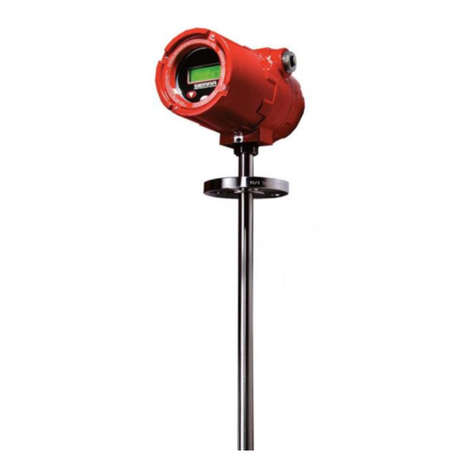
Sierra
Sierra Profibus DP 600 Series instruction manual
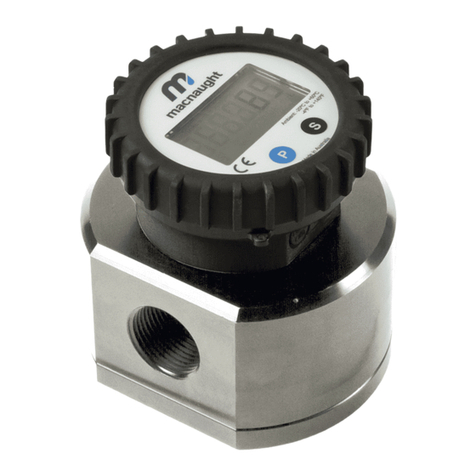
Macnaught
Macnaught MX06S instruction manual
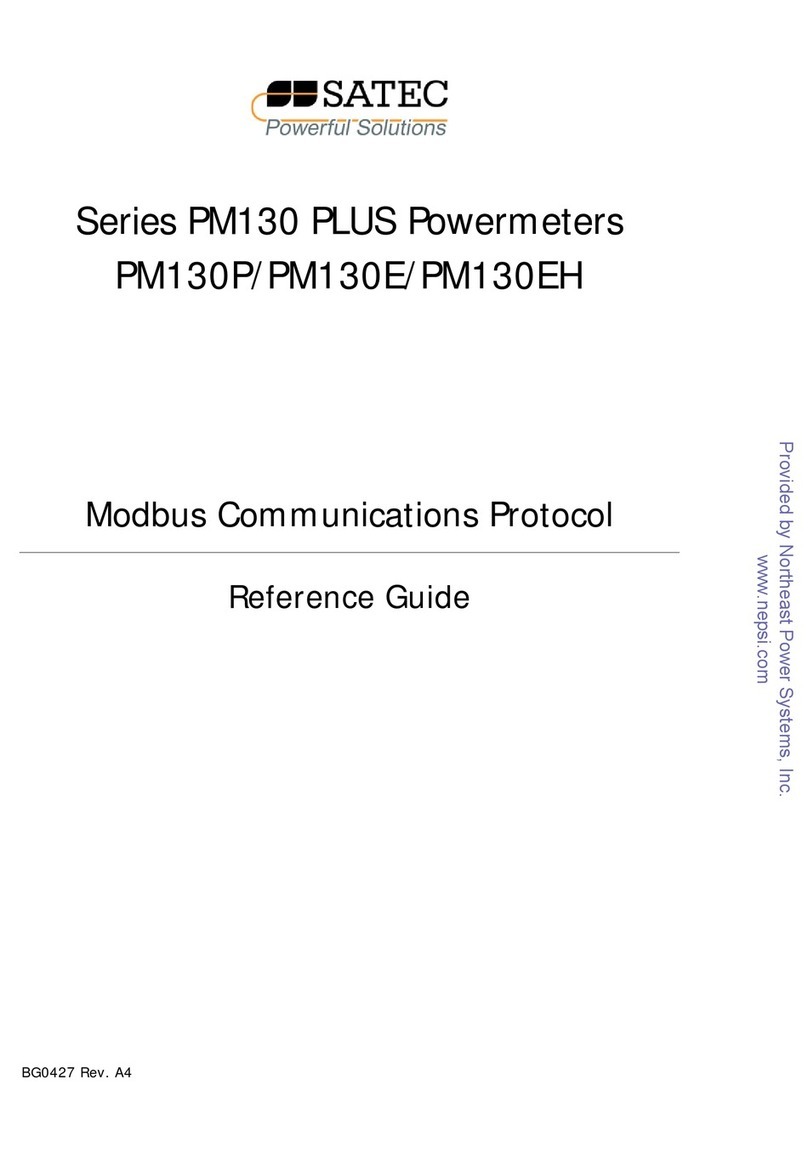
Satechi
Satechi pm130p reference guide
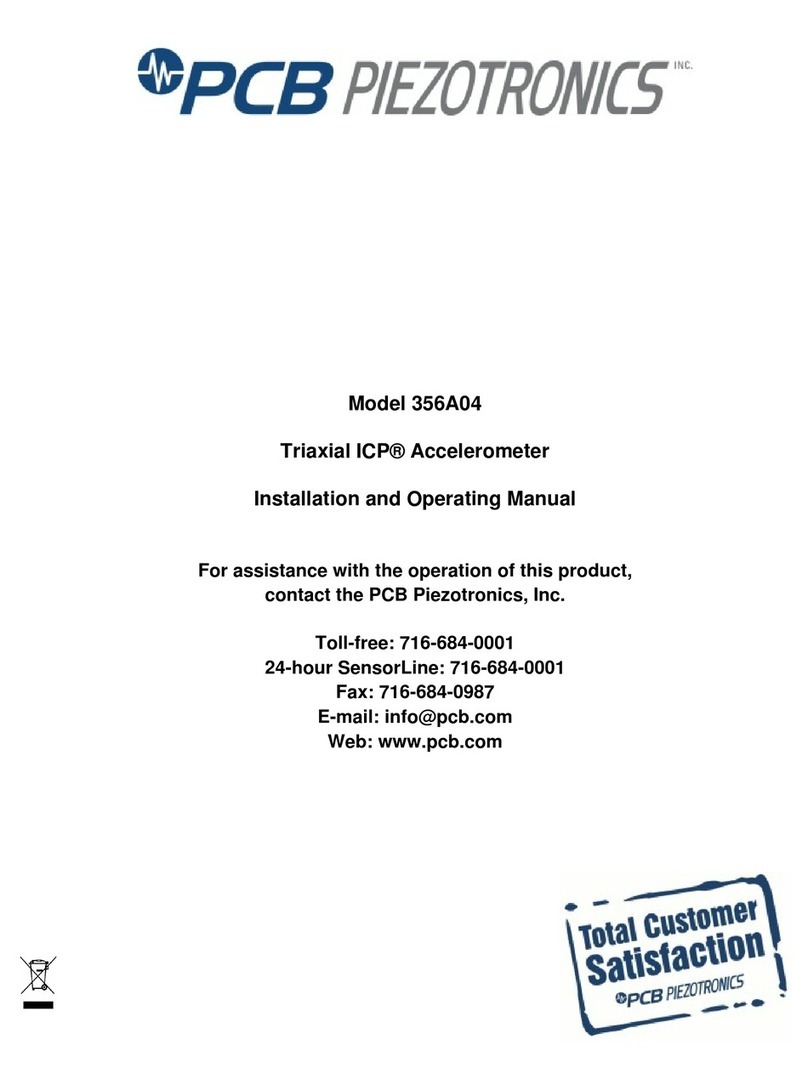
PCB Piezotronics
PCB Piezotronics ICP 356A04 Installation and operating manual
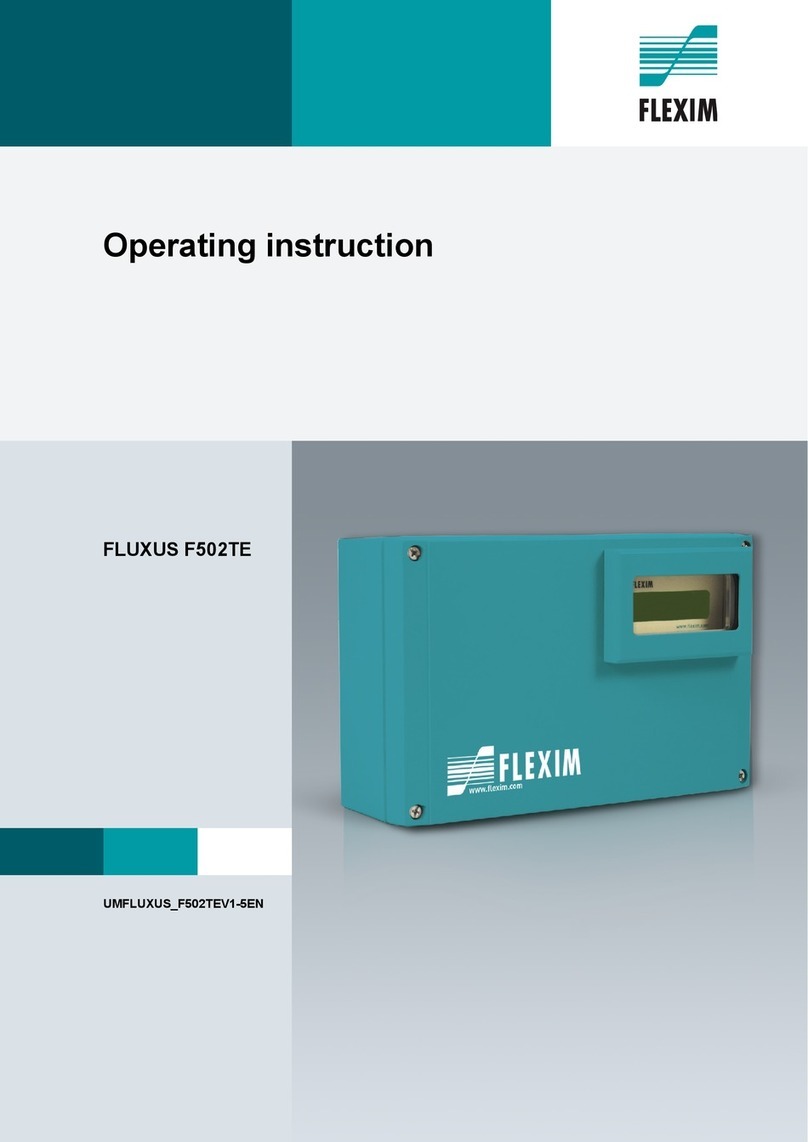
Flexim
Flexim FLUXUS F502TE Operating instruction
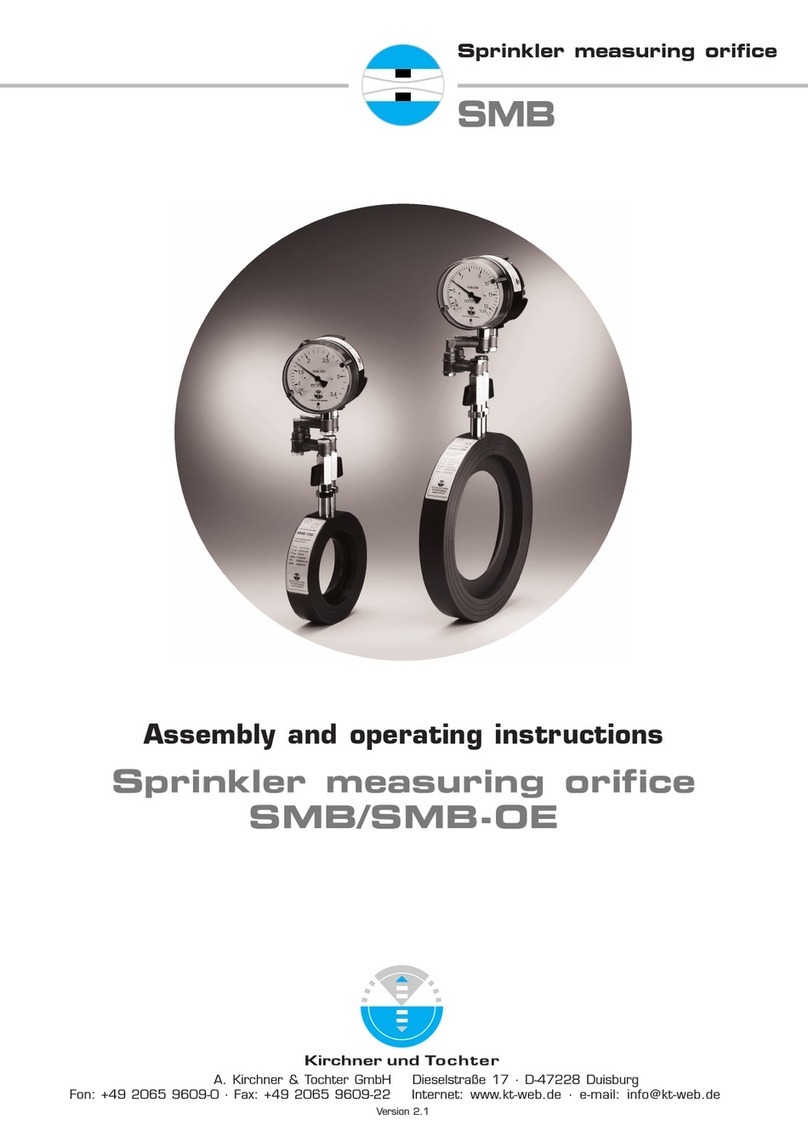
Kirchner und Tochter
Kirchner und Tochter SMB Series Assembly and operating instructions


